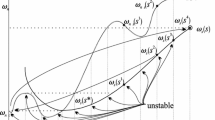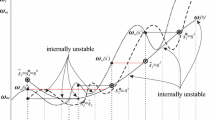Abstract
We study the impact of collective effort in R&D in adaptation technologies, and also spillover effects on formation and size of stable international environmental agreements (IEAs). Our results suggest that it is possible to have more than one size of stable IEA. We can achieve a superior equilibrium, i.e., the grand coalition, if countries manage to keep knowledge spillovers low and arrange a minimum ratification threshold. This threshold is defined endogenously. We also shed light on the effects of two-sided spillover on global welfare and the size of stable IEAs.




Similar content being viewed by others
Notes
See the seminal paper by D’Aspremont and Jacquemin (1988).
Note that we adopt the open membership assumption as in, e.g., the Kyoto protocol and Paris agreement, which means that insiders cannot block an entrant.
It turned out in all simulations that when emissions and the damage costs are positive, welfare is also positive; see “Appendix 2”.
The results for any other constellation of parameter values can be provided by the authors upon request.
For instance, the Vienna Convention and the Montreal Protocol were initially signed by 28 and 46 countries, respectively, and both achieved universal ratification on 16 September 2009, we may interpret our \(S^{mpc}\) as 28 for the Vienna Convention and 46 for the Montreal Protocol.
References
Barrett S (1994) Self-enforcing international environmental agreements. Oxf Econ Papers 46:878–894
Barrett S (2013) Climate treaties and approaching catastrophes. J Environ Econ Manag 66(2):235–250
Benchekroun H, Marrouch W, Chaudhuri A (2011) Adaptation effectiveness and free-riding incentives in international environmental agreements. Tilburg University, Center for Economic Research, Tilburg
Carraro C, Siniscalco D (1993) Strategies for the international protection of the environment. J Public Econ 52(3):309–328
Carraro C, Marchiori C, Oreffice S (2009) Endogenous minimum participation in international environmental treaties. Environ Resour Econ 42(3):411–425
Courtois P, Haeringer G (2005) The making of international environmental agreements. UFAE and IAE Working Papers, 652.05
D’Aspremont C, Jacquemin A (1988) Cooperative and noncooperative R&D in duopoly with spillovers. Am Econ Rev 78:1133–1137
D’Aspremont C, Jacquemin A, Gabszewicz JJ, Weymark JA (1983) On the stability of collusive price leadership. Can J Econ 16(1):17–25
Diamantoudi E, Sartzetakis ES (2006) Stable international environmental agreements: an analytical approach. J Public Econ Theory 8(2):247–263
Dockner EJ, Long NV (1993) International pollution control: cooperative versus noncooperative strategies. J Environ Econ Manag 25(1):13–29
Finus M (2003) Stability and design of international environmental agreements: the case of transboundary pollution. In: Folmer H, Tietenberg T (eds) The international yearbook of environmental and resource economics 2003/2004: a survey of current issues. Edward Elgar, Cheltenham, pp 82–158
Finus M (2008) Game theoretic research on the design of international environmental agreements: insights, critical remarks, and future challenges. Int Rev Environ Resour Econ 2(1):29–67
IPCC (2013) Fifth assessment report, the physical science basis, summary for policymakers. Technical report
Kamien M, Zang I (2000) Meet me halfway: research joint ventures and absorptive capacity. Int J Ind Organ 18:995–1012
Lazkano I, Marrouch W, Nkuiya B (2014) Adaptation to climate change: How does heterogeneity in adaptation costs affect climate coalitions? SSRN Working Paper
Leahy D, Neary J (2007) Absorptive capacity, R&D spillovers, and public policy. Int J Ind Organ 25:1089–1108
Long NV (1992) Pollution control: a differential game approach. Ann Oper Res 37:283–296
Marrouch W, Chaudhuri R (2011) International environmental agreements in the presence of adaptation. Discussion Paper 2011.35, Fondazione Eni Enrico Mattei
Milliou C (2009) Endogenous protection of R&D investments. Can J Econ 42:184–205
Pavlova Y, de Zeeuw A (2013) Asymmetries in international environmental agreements. Environ Dev Econ 18:51–68
Rubio SJ, Casino B (2005) Self-enforcing international environmental agreements with a stock pollutant. Span Econ Rev 7(2):89–109
UNFCCC (2006) Technologies for adaptation to climate change. Technical report
Wiethaus L (2007) Absorptive capacity and connectedness: why competing firms also adopt identical R&D approaches. Int J Ind Organ 23:467–481
WRI (2009) Bellagio framework for adaptation assessment and prioritization. Technical report, World Resource Institute
Acknowledgments
Funding was provided by SHHRC (Grant No. 435-2013-0532).
Author information
Authors and Affiliations
Corresponding author
Additional information
We wish to thank the two anonymous reviewers and the editor for their very helpful comments.
Appendices
Appendix 1: Proof of Proposition 3.1
First-order conditions for 10 and 9 provide the following 4-unknown, 4-equation system:
Solving for the variables \(e^{N}, \, \kappa ^{N},\,e^{S}\) and \({\kappa ^{S}}\) gives the result.
Appendix 2: Calibration of the Parameters \(\gamma \) and \(\theta \)
Calibration of main parameters (\(\gamma \) and \(\theta \)), where \(M=100,\) \(c=0.37\), \(\beta =0.0008\), \(K=7.5\) and \(\alpha =0.5\). a Region with positive individual emissions (\(e^{S}>0\)and \(e^{N}>0\)), b region where adaptation doesn’t overweight environmental damages (\(D\left( \mathscr {E},K_{i}\right) \ge 0\)), c region with non-negative welfare for signatories (\(W_{i}^{S}\ge 0\)), d region with non-negative welfare for non-signatories (\(W_{i}^{NS}\ge 0\))
Calibration of main parameters (\(\gamma \) and \(\theta \)), where \(M=50,\) \(c=0.37\), \(\beta =0.0008\), \(K=6\) and \(\alpha =0.5\). a Region with positive individual emissions (\(e^{S}>0\)and \(e^{N}>0\)), b region where adaptation doesn’t overweight environmental damages (\(D\left( \mathscr {E},K_{i}\right) \ge 0\)), c region with non-negative welfare for signatories (\(W_{i}^{S}\ge 0\)), d region with non-negative welfare for non-signatories (\(W_{i}^{NS}\ge 0\))
Rights and permissions
About this article
Cite this article
Masoudi, N., Zaccour, G. Adaptation and International Environmental Agreements. Environ Resource Econ 71, 1–21 (2018). https://doi.org/10.1007/s10640-016-0080-9
Accepted:
Published:
Issue Date:
DOI: https://doi.org/10.1007/s10640-016-0080-9
Keywords
- International environmental agreements
- Adaptation technology
- Minimum participation clause
- Climate change
- Knowledge spillover






